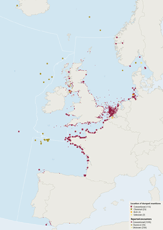Vast amounts of munitions were dumped at designated sites or randomly jettisoned into the sea following the First and Second World Wars. These included conventional munitions such as bombs, grenades, torpedoes and mines, as well as incendiary devices and chemical munitions.
The presence of munitions in the sea is a risk to fishermen and coastal users. As recently as 2005, three fishermen were killed in the southern North Sea when a Second World War bomb exploded on their fishing vessel after having been caught in their nets. There are also concerns over the many chemicals used in the munitions, which may be released as the munitions degrade with the possibility of risks for the marine food chain. However, there is no evidence of this in the OSPAR area at present. The few data that are available indicate little or no contamination of fish, shellfish or sediments near the dumpsites. A study at the Beaufort’s Dyke dumpsite in the Irish Sea (Region III) in 1996 found no evidence of chemicals from conventional and chemical warfare agents in sediments, fish or shellfish. Levels of naturally occurring metals used in munitions, such as arsenic and heavy metals, were within the range expected around the UK. Belgian studies have shown that contamination of sediment with mustard gas from a Second World War shell is limited to 3 cm from the shell. Explosion of munitions may be a greater environmental concern both through release of hazardous substances and the impacts of noise. The high sound pressure generated by spontaneous or controlled explosions of munitions can injure or kill marine mammals and fish. Harbour porpoises have been reported killed within 4 km of explosions and suffering permanent hearing damage up to 30 km away.
Information on the amounts and locations of dumped munitions is recognised to be incomplete, but the existence of dumped munitions should be a consideration in marine spatial planning.
In 2004, OSPAR began a programme to establish the extent of munitions dumping and to monitor the frequency of encounters Figure 9.12. This has revealed that munitions were dumped at 148 sites and that 1879 encounters with munitions have occurred since 2004. Around 58% of reported munitions were encountered by fishermen and 29% found on the shore. Most (76%) were removed from the sea or neutralised; 11% were returned to the sea for safety reasons.
To reduce risk to fishermen and coastal users, OSPAR prepared a framework for the development of national guidelines on what to do when munitions are encountered. There are serious safety risks associated with the clean-up of dumpsites, as well as increased risk of dispersing hazardous substances. The most common management practice is to leave munitions on the seabed and allow them to disintegrate naturally. If munitions must be removed from the seabed, the potential of new techniques which allow neutralisation without explosion should be considered.
Although knowledge has increased, OSPAR should continue to collate data on encounters with dumped munitions and keep under review new techniques for managing the risks from munitions. Planning and management of marine activities should take into account the risks from dumped munitions. Explosions should be avoided due to concerns over underwater noise and the spread of hazardous substances. National guidelines should be issued for fishermen and other coastal users on what to do when munitions are encountered. National authorities should consider supplying fishermen with sub-surface marker buoys to use in the case of encounters. OSPAR should encourage the development of techniques for safe removal and neutralisation without explosion and promote the monitoring of possible effects of dumped munitions in the North-East Atlantic.


